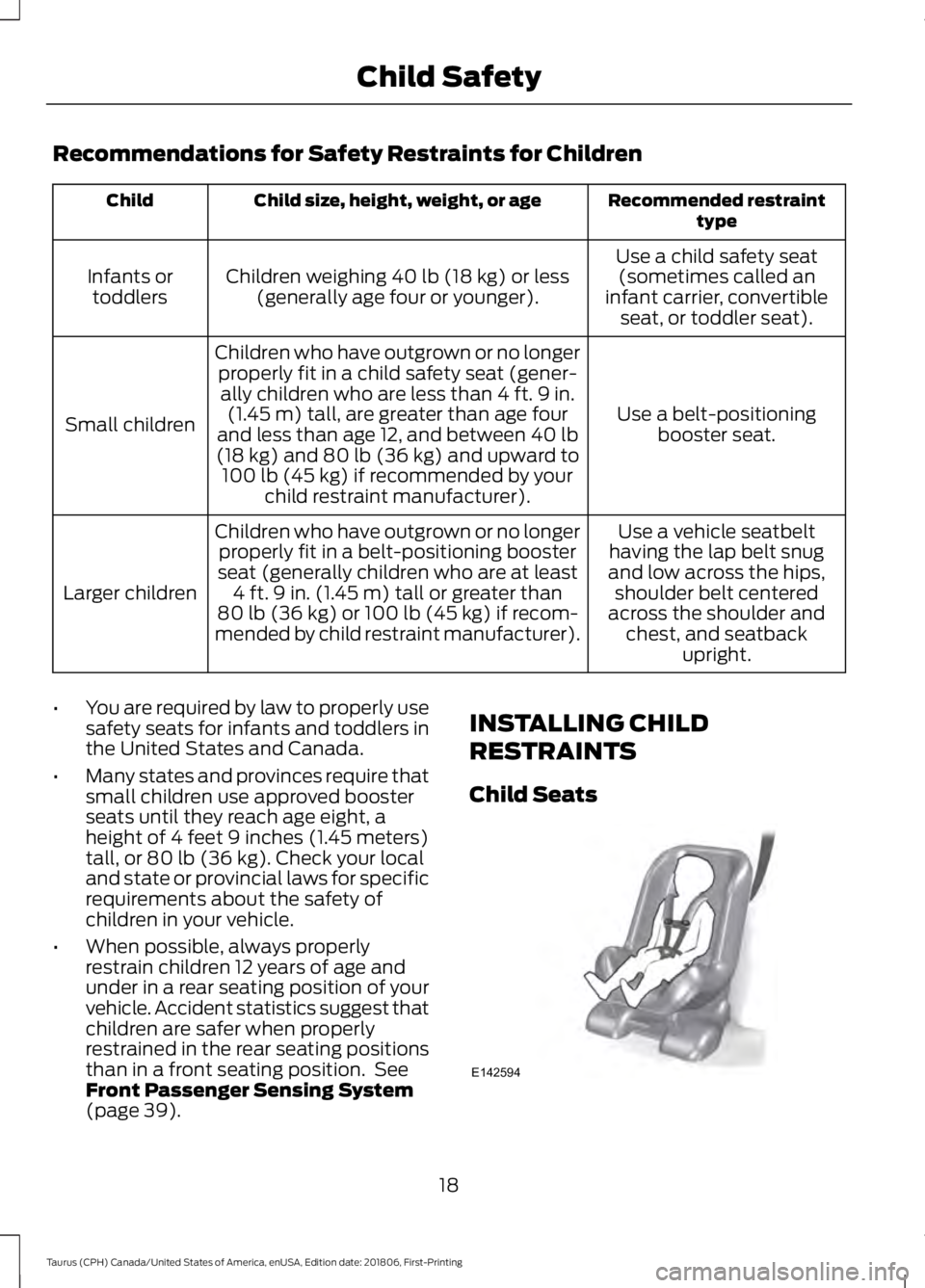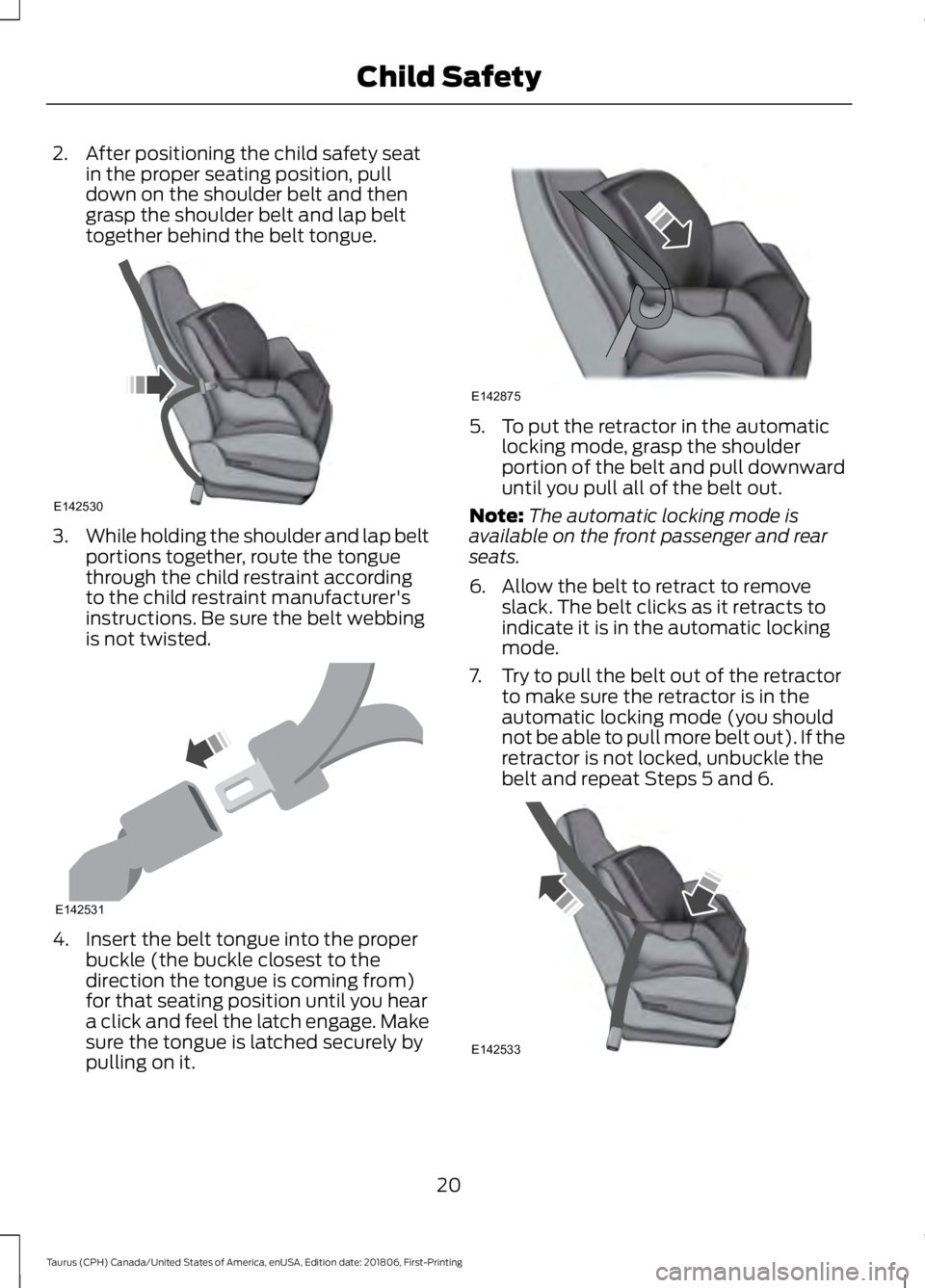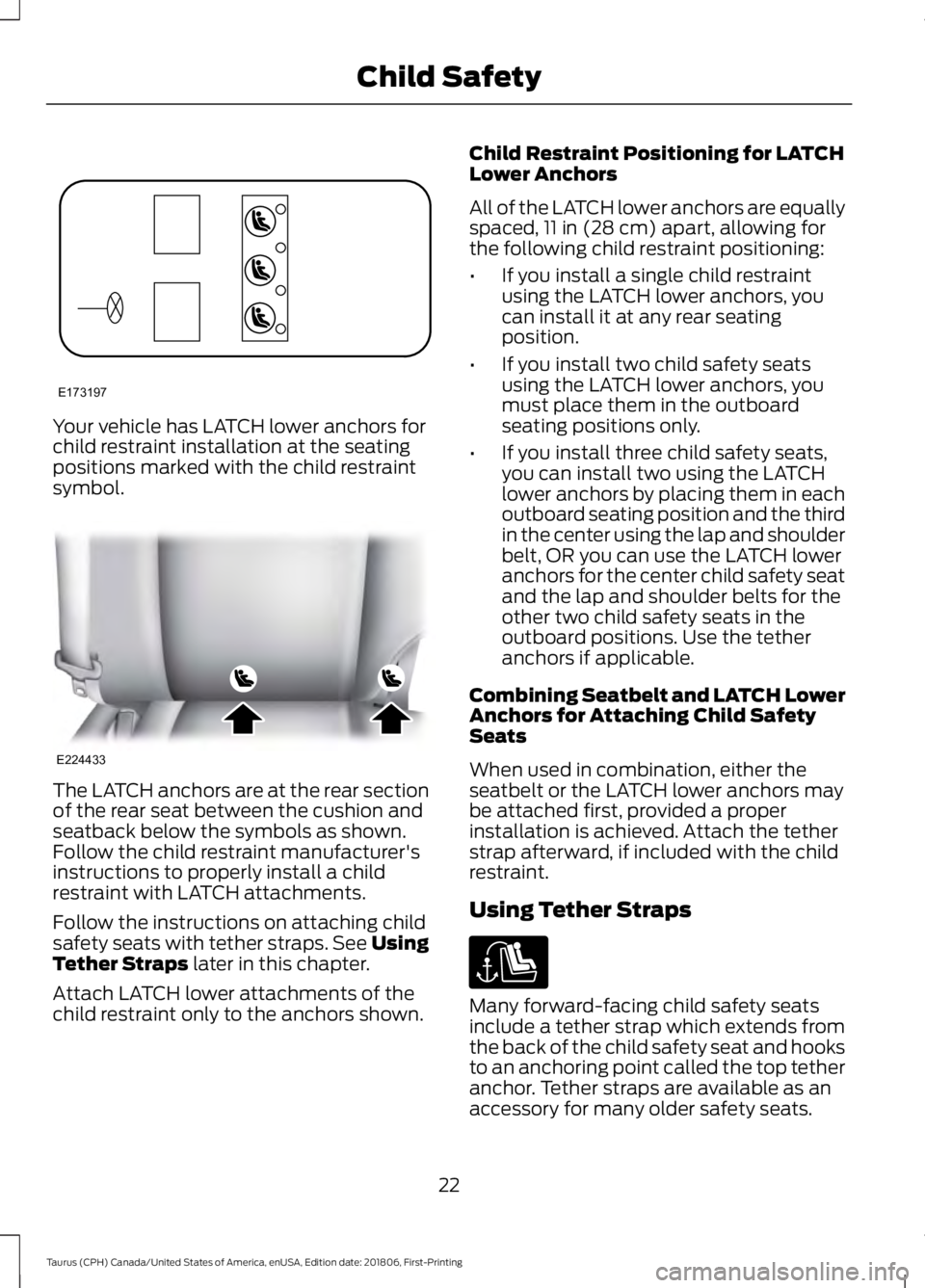2019 FORD TAURUS seats
[x] Cancel search: seatsPage 4 of 515

Introduction
About This Manual
..........................................7
Symbols Glossary ............................................
7
Data Recording .................................................
9
Perchlorate ........................................................
11
Ford Credit .........................................................
11
Replacement Parts Recommendation ........................................................................\
....
12
Special Notices ...............................................
12
Mobile Communications Equipment ........................................................................\
....
13
Export Unique Options .................................
13
Environment
Protecting the Environment .......................
14
At a Glance
Instrument Panel Overview ........................
15
Child Safety
General Information ......................................
17
Installing Child Restraints ...........................
18
Booster Seats .................................................
24
Child Restraint Positioning ........................
26
Child Safety Locks ........................................
28
Seatbelts
Principle of Operation .................................
29
Fastening the Seatbelts .............................
30
Seatbelt Height Adjustment .....................
32
Seatbelt Warning Lamp and Indicator Chime .............................................................
32
Seatbelt Reminder ........................................
33
Child Restraint and Seatbelt Maintenance ...............................................
34
Seatbelt Extension .......................................
35
Personal Safety System ™
Personal Safety System ™.........................
36 Supplementary Restraints
System
Principle of Operation ..................................
37
Driver and Passenger Airbags ..................
38
Front Passenger Sensing System ...........
39
Side Airbags .....................................................
41
Safety Canopy ™............................................
42
Crash Sensors and Airbag Indicator ......
44
Airbag Disposal ..............................................
45
Keys and Remote Controls
General Information on Radio Frequencies ................................................
46
Remote Control .............................................
46
Replacing a Lost Key or Remote Control ........................................................................\
..
50
MyKey ™
Principle of Operation ..................................
51
Creating a MyKey ...........................................
52
Clearing All MyKeys ......................................
52
Checking MyKey System Status ..............
53
Using MyKey With Remote Start Systems ........................................................
53
MyKey Troubleshooting ..............................
53
Doors and Locks
Locking and Unlocking ................................
55
Keyless Entry ..................................................
58
Interior Luggage Compartment Release ........................................................................\
..
60
Security
Passive Anti-Theft System ........................
62
Anti-Theft Alarm ...........................................
63
Steering Wheel
Adjusting the Steering Wheel ..................
64
Audio Control .................................................
64
Voice Control ..................................................
64
1
Taurus (CPH) Canada/United States of America, enUSA, Edition date: 201806, First-Printing Table of Contents
Page 5 of 515

Cruise Control
.................................................65
Information Display Control ......................
65
Heated Steering Wheel ..............................
65
Pedals
Adjusting the Pedals ...................................
66
Wipers and Washers
Windshield Wipers ........................................
67
Autowipers .......................................................
67
Windshield Washers ....................................
68
Lighting
General Information ....................................
69
Lighting Control .............................................
69
Autolamps .......................................................
70
Instrument Lighting Dimmer ....................
70
Headlamp Exit Delay .....................................
71
Daytime Running Lamps .............................
71
Automatic High Beam Control ..................
71
Direction Indicators .......................................
72
Interior Lamps .................................................
73
Ambient Lighting ...........................................
73
Windows and Mirrors
Power Windows .............................................
74
Global Opening ..............................................
75
Exterior Mirrors ................................................
75
Interior Mirror ...................................................
77
Sun Visors .........................................................
77
Moonroof ...........................................................
77
Instrument Cluster
Gauges ...............................................................
79
Warning Lamps and Indicators .................
81
Audible Warnings and Indicators ............
84
Information Displays
General Information .....................................
85Information Messages
................................
94
Climate Control
Manual Climate Control ...........................
105
Automatic Climate Control - Vehicles With: Sony Audio System ....................
106
Automatic Climate Control - Vehicles With: SYNC ................................................
107
Automatic Climate Control - Vehicles With: SYNC 3 ............................................
109
Hints on Controlling the Interior Climate ........................................................................\
..
110
Heated Rear Window ..................................
112
Heated Exterior Mirrors ...............................
112
Cabin Air Filter ................................................
113
Remote Start ..................................................
113
Seats
Sitting in the Correct Position ..................
114
Head Restraints .............................................
114
Manual Seats .................................................
116
Power Seats ....................................................
117
Memory Function ........................................
120
Rear Seats .......................................................
121
Heated Seats ..................................................
121
Climate Controlled Seats ..........................
122
Universal Garage Door Opener
Universal Garage Door Opener ..............
124
Auxiliary Power Points
Auxiliary Power Points ...............................
129
Storage Compartments
Center Console .............................................
130
Overhead Console ......................................
130
Rear Seat Armrest .......................................
130
2
Taurus (CPH) Canada/United States of America, enUSA, Edition date: 201806, First-Printing Table of Contents
Page 7 of 515

Roadside Emergencies
Roadside Assistance
..................................210
Hazard Flashers .............................................
211
Fuel Shutoff ....................................................
211
Jump Starting the Vehicle .........................
212
Post-Crash Alert System ..........................
214
Transporting the Vehicle ...........................
214
Customer Assistance
Getting the Services You Need ...............
216
In California (U.S. Only) .............................
217
The Better Business Bureau (BBB) Auto Line Program (U.S. Only) .....................
218
Utilizing the Mediation/Arbitration Program (Canada Only) .......................
219
Getting Assistance Outside the U.S. and Canada ........................................................
219
Ordering Additional Owner's Literature ........................................................................\
.
221
Reporting Safety Defects (U.S. Only) ........................................................................\
.
221
Reporting Safety Defects (Canada Only) ........................................................................\
.
221
Fuses
Fuse Specification Chart ..........................
223
Changing a Fuse ..........................................
232
Maintenance
General Information ..................................
234
Opening and Closing the Hood .............
234
Under Hood Overview - 3.5L Duratec ........................................................................\
235
Under Hood Overview - 3.5L Ecoboost™ ........................................................................\
.
237
Engine Oil Dipstick - 3.5L Duratec/3.5L Ecoboost™ ...............................................
238
Engine Oil Check .........................................
238
Oil Change Indicator Reset .....................
239
Engine Coolant Check ..............................
240
Automatic Transmission Fluid Check - 3.5L Duratec/3.5L Ecoboost™ .........
244Brake Fluid Check
.......................................
247
Power Steering Fluid Check ...................
248
Washer Fluid Check ...................................
248
Fuel Filter .......................................................
248
Changing the 12V Battery ........................
248
Checking the Wiper Blades ....................
250
Changing the Wiper Blades .....................
251
Adjusting the Headlamps .........................
251
Changing a Bulb ..........................................
252
Changing the Engine Air Filter ................
253
Vehicle Care
General Information ..................................
255
Cleaning Products ......................................
255
Cleaning the Exterior .................................
255
Waxing .............................................................
257
Cleaning the Engine ...................................
257
Cleaning the Windows and Wiper Blades ........................................................................\
257
Cleaning the Interior ..................................
258
Cleaning the Instrument Panel and Instrument Cluster Lens ......................
258
Cleaning Leather Seats ............................
259
Repairing Minor Paint Damage .............
260
Cleaning the Wheels .................................
260
Vehicle Storage ...........................................
260
Wheels and Tires
General Information ..................................
263
Tire Sealant and Inflator Kit ...................
263
Tire Care .........................................................
269
Using Summer Tires ..................................
282
Using Snow Chains ....................................
282
Tire Pressure Monitoring System ..........
283
Changing a Road Wheel ..........................
287
Technical Specifications ...........................
291
4
Taurus (CPH) Canada/United States of America, enUSA, Edition date: 201806, First-Printing Table of Contents
Page 21 of 515

Recommendations for Safety Restraints for Children
Recommended restraint
type
Child size, height, weight, or age
Child
Use a child safety seat(sometimes called an
infant carrier, convertible seat, or toddler seat).
Children weighing 40 lb (18 kg) or less
(generally age four or younger).
Infants or
toddlers
Use a belt-positioningbooster seat.
Children who have outgrown or no longer
properly fit in a child safety seat (gener-ally children who are less than 4 ft. 9 in. (1.45 m) tall, are greater than age four
and less than age 12, and between
40 lb
(18 kg) and 80 lb (36 kg) and upward to
100 lb (45 kg) if recommended by your
child restraint manufacturer).
Small children
Use a vehicle seatbelt
having the lap belt snug
and low across the hips, shoulder belt centered
across the shoulder and chest, and seatback upright.
Children who have outgrown or no longer
properly fit in a belt-positioning booster
seat (generally children who are at least 4 ft. 9 in. (1.45 m) tall or greater than
80 lb (36 kg)
or 100 lb (45 kg) if recom-
mended by child restraint manufacturer).
Larger children
• You are required by law to properly use
safety seats for infants and toddlers in
the United States and Canada.
• Many states and provinces require that
small children use approved booster
seats until they reach age eight, a
height of 4 feet 9 inches (1.45 meters)
tall, or
80 lb (36 kg). Check your local
and state or provincial laws for specific
requirements about the safety of
children in your vehicle.
• When possible, always properly
restrain children 12 years of age and
under in a rear seating position of your
vehicle. Accident statistics suggest that
children are safer when properly
restrained in the rear seating positions
than in a front seating position. See
Front Passenger Sensing System
(page
39). INSTALLING CHILD
RESTRAINTS
Child Seats
18
Taurus (CPH) Canada/United States of America, enUSA, Edition date: 201806, First-Printing Child SafetyE142594
Page 23 of 515

2. After positioning the child safety seat
in the proper seating position, pull
down on the shoulder belt and then
grasp the shoulder belt and lap belt
together behind the belt tongue. 3.
While holding the shoulder and lap belt
portions together, route the tongue
through the child restraint according
to the child restraint manufacturer's
instructions. Be sure the belt webbing
is not twisted. 4. Insert the belt tongue into the proper
buckle (the buckle closest to the
direction the tongue is coming from)
for that seating position until you hear
a click and feel the latch engage. Make
sure the tongue is latched securely by
pulling on it. 5. To put the retractor in the automatic
locking mode, grasp the shoulder
portion of the belt and pull downward
until you pull all of the belt out.
Note: The automatic locking mode is
available on the front passenger and rear
seats.
6. Allow the belt to retract to remove slack. The belt clicks as it retracts to
indicate it is in the automatic locking
mode.
7. Try to pull the belt out of the retractor to make sure the retractor is in the
automatic locking mode (you should
not be able to pull more belt out). If the
retractor is not locked, unbuckle the
belt and repeat Steps 5 and 6. 20
Taurus (CPH) Canada/United States of America, enUSA, Edition date: 201806, First-Printing Child SafetyE142530 E142531 E142875 E142533
Page 24 of 515

8.
Remove remaining slack from the belt.
Force the seat down with extra weight,
for example, by pressing down or
kneeling on the child restraint while
pulling up on the shoulder belt in order
to force slack from the belt. This is
necessary to remove the remaining
slack that exists once the extra weight
of the child is added to the child
restraint. It also helps to achieve the
proper snugness of the child restraint
to your vehicle. Sometimes, a slight
lean toward the buckle provides extra
help to remove remaining slack from
the belt.
9. Attach the tether strap (if the child restraint is equipped). 10. Before placing the child in the seat,
forcibly move the seat forward and
back to make sure the seat is securely
held in place. To check this, grab the
seat at the belt path and attempt to
move it side to side and forward and
back. There should be no more than
1 in (2.5 cm) of movement for proper
installation.
We recommend checking with a NHTSA
Certified Child Passenger Safety
Technician to make certain the child
restraint is properly installed. In Canada,
check with Transport Canada for referral
to a Child Car Seat Clinic. Using Lower Anchors and Tethers
for CHildren (LATCH) WARNING: Do not attach two
child safety restraints to the same
anchor. In a crash, one anchor may not
be strong enough to hold two child
safety restraint attachments and may
break, causing serious injury or death. WARNING:
Depending on where
you secure a child restraint, and
depending on the child restraint design,
you may block access to certain seatbelt
buckle assemblies and LATCH lower
anchors, rendering those features
potentially unusable. To avoid risk of
injury, make sure occupants only use
seating positions where they are able to
be properly restrained.
The LATCH system is composed of three
vehicle anchor points: two lower anchors
where the seatback and seat cushion meet
(called the seat bight) and one top tether
anchor behind that seating position.
LATCH compatible child safety seats have
two rigid or webbing mounted
attachments that connect to the two lower
anchors at the LATCH equipped seating
positions in your vehicle. This type of
attachment method eliminates the need
to use seatbelts to attach the child
restraint. However, you can still use the
seatbelt to attach the child restraint. For
forward-facing child restraints, you must
also attach the top tether strap to the
proper top tether anchor, if a top tether
strap has been provided with your child
restraint.
21
Taurus (CPH) Canada/United States of America, enUSA, Edition date: 201806, First-Printing Child SafetyE142534
Page 25 of 515

Your vehicle has LATCH lower anchors for
child restraint installation at the seating
positions marked with the child restraint
symbol.
The LATCH anchors are at the rear section
of the rear seat between the cushion and
seatback below the symbols as shown.
Follow the child restraint manufacturer's
instructions to properly install a child
restraint with LATCH attachments.
Follow the instructions on attaching child
safety seats with tether straps. See Using
Tether Straps later in this chapter.
Attach LATCH lower attachments of the
child restraint only to the anchors shown. Child Restraint Positioning for LATCH
Lower Anchors
All of the LATCH lower anchors are equally
spaced, 11 in (28 cm) apart, allowing for
the following child restraint positioning:
•
If you install a single child restraint
using the LATCH lower anchors, you
can install it at any rear seating
position.
• If you install two child safety seats
using the LATCH lower anchors, you
must place them in the outboard
seating positions only.
• If you install three child safety seats,
you can install two using the LATCH
lower anchors by placing them in each
outboard seating position and the third
in the center using the lap and shoulder
belt, OR you can use the LATCH lower
anchors for the center child safety seat
and the lap and shoulder belts for the
other two child safety seats in the
outboard positions. Use the tether
anchors if applicable.
Combining Seatbelt and LATCH Lower
Anchors for Attaching Child Safety
Seats
When used in combination, either the
seatbelt or the LATCH lower anchors may
be attached first, provided a proper
installation is achieved. Attach the tether
strap afterward, if included with the child
restraint.
Using Tether Straps Many forward-facing child safety seats
include a tether strap which extends from
the back of the child safety seat and hooks
to an anchoring point called the top tether
anchor. Tether straps are available as an
accessory for many older safety seats.
22
Taurus (CPH) Canada/United States of America, enUSA, Edition date: 201806, First-Printing Child SafetyE173197 E224433
Page 27 of 515

5. Tighten the child safety seat tether
strap according to the manufacturer's
instructions.
If the safety seat is not anchored properly,
the risk of a child being injured in a crash
greatly increases.
If your child restraint system has a tether
strap, and the child restraint manufacturer
recommends its use, we also recommend
its use.
BOOSTER SEATS WARNING: Do not put the
shoulder section of the seatbelt or allow
the child to put the shoulder section of
the seatbelt under their arm or behind
their back. Failure to follow this
instruction could reduce the
effectiveness of the seatbelt and
increase the risk of injury or death in a
crash.
Use a belt-positioning booster seat for
children who have outgrown or no longer
properly fit in a child safety restraint
(generally children who are less than
57 in
(1.45 m) tall, are greater than age 4 and
less than age 12, and between 40 lb (18 kg)
and
80 lb (36 kg) and upward to 100 lb
(45 kg) if recommended by your child
restraint manufacturer). Many state and
provincial laws require that children use
approved booster seats until they reach
age eight, a height of
57 in (1.45 m) tall, or
80 lb (36 kg).
Booster seats should be used until you can
answer YES to ALL of these questions
when seated without a booster seat: •
Can the child sit all the way back
against their vehicle seat backrest with
knees bent comfortably at the edge of
the seat cushion?
• Can the child sit without slouching?
• Does the lap belt rest low across the
hips?
• Is the shoulder belt centered on the
shoulder and chest?
• Can the child stay seated like this for
the whole trip?
Always use booster seats in conjunction
with your vehicle lap and shoulder belt.
Types of Booster Seats •
Backless booster seats
24
Taurus (CPH) Canada/United States of America, enUSA, Edition date: 201806, First-Printing Child SafetyE142595 E68924